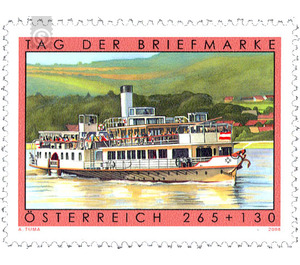day of the stamp - Austria / II. Republic of Austria 2008 - 265 Euro Cent
Theme: Traffic, Transportation & Mobility
| Country | Austria / II. Republic of Austria |
| Issue Date | 2008 |
| Face Value | 265.00 |
| Edition Issued | 660,000 |
| Printing Type | Photogravure |
| Stamp Type | Semi-Postal |
| Item Type | Stamp |
| Chronological Issue Number | 2103 |
| Chronological Chapter | OOS-OE2 |
| SID | 322102 |
| In 57 Wishlists | |
The paddle steamer SCHÖNBRUNN was built in 1912 together with its two sister ships BUDAPEST and WIEN in the shipyard Obuda (old furnace) of the DDSG. The two passenger steamers ERZHERZOG FRANZ FERDINAND and DUCHESS VON HOHENBERG, which were renamed JOHANN STRAUSS and FRANZ SCHUBERT after World War I, were mainly used to improve the regular service between Vienna and Linz or Vienna and Vienna Budapest destined. The SCHÖNBRUNN is 74.62 m long, with a total width of 15.78 m and a maximum draft of 1.73 m. The inclined compound steam engine provides 710 hp. It survived the turmoil of both world wars well and was converted in 1954 from coal to oil firing, at the same time their superstructures were renewed. In the aftermath, it came to other conversions, in particular, the interior of the ship should give a look after the Art Nouveau look. However, the labor-intensive steam operation made economic use increasingly difficult. The SCHÖNBUNN therefore landed for a few years as a floating casino in Budapest, then in 1994 it was in the center of the held in Engelhartszell Upper Austrian Provincial Exhibition. In the meantime, the DDSG had been smashed and the fate of the wheel steamer was therefore extremely uncertain. In order to prevent its scrapping, which seems unavoidable under these circumstances, the management decided in 1995 to put the ship under protection as a technical monument and offer it to the Austrian Railway Company (ÖGEG) for the price of one schilling plus 20% VAT. This company has made the SCHÖNBRUNN operational again at great expense and undertakes several nostalgic trips every year on the Austrian Danube. Thus the SCHÖNBRUNN remained the oldest still usable passenger steamer on the Danube. Postal transport on the Danube through DDSG ships can look back on a long tradition. The DDSG, founded in 1829, started traffic to Budapest as early as 1830 and quickly extended its line network to the mouth of the Danube. In 1834 her first maritime vessel MARIA DOROTHEA was put into operation. With the ever-growing fleet, including a total of seven ships, both the Danube route and Constantinople and the eastern Mediterranean was served. In 1845, the ships were sold to the Austrian Lloyd; After that, DDSG mail transport was confined to the Lower Danube, but it became more and more important, so that in 1866 the company even circulated own stamps worth 10 and 17 kreuzers, but these were only in use until 1880 are. In the timetables of the DDSG so-called mail boats still appear until 1939. This term was still in use for a long time, although on these lines no regular mail transport took place. The fact that 180 years after the founding of the DDSG a stamp with the most well-known still operational steamship of this society appears, certainly contributes to a company rich in tradition and important for the Austrian economy.


